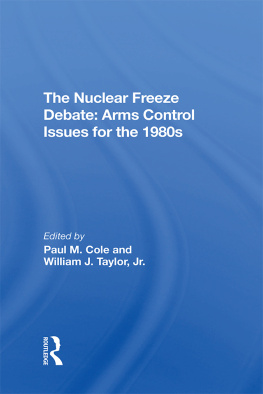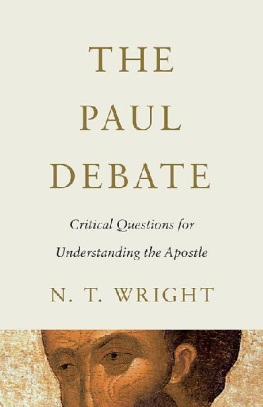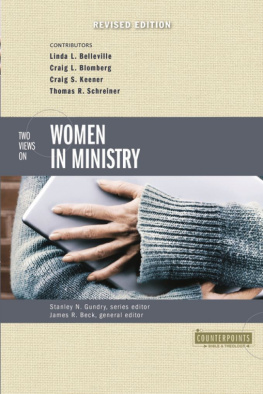First published 1989 by Transaction Publishers
Published 2019 by Routledge
2 Park Square, Milton Park, Abingdon, Oxon OX14 4RN
52 Vanderbilt Avenue, New York, NY 10017
Routledge is an imprint of the Taylor & Francis Group, an informa business
Copyright 1989 by Taylor & Francis
All rights reserved. No part of this book may be reprinted or reproduced or utilised in any form or by any electronic, mechanical, or other means, now known or hereafter invented, including photocopying and recording, or in any information storage or retrieval system, without permission in writing from the publishers.
Notice:
Product or corporate names may be trademarks or registered trademarks, and are used only for identification and explanation without intent to infringe.
Library of Congress Catalog Number: 88-4760
Library of Congress Cataloging-in-Publication Data
Paul, Ellen Frankel.
Equity and gender.
Bibliography: p.
Includes index.
1. Pay equityLaw and legislationUnited States.
2. Pay equityUnited States. I. Title.
KF3467.P38 344.730121 88-4760
ISBN 0-88738-204-5 347.304121
ISBN 0-88738-720-9 (pbk.)
ISBN 13: 978-0-88738-204-8 (hbk)
ISBN 13: 978-0-88738-720-3 (pbk)
James Dorn and David Boaz of the Cato Institute displayed great patience and encouragement throughout the writingor for long stretches of timenon-writing of this book. For their patience, no less than their editorial skill, I wish to thank them most sincerely.
Carol Olson, staff research analyst for the Iowa Senate Republican caucus and Malcolm J. Sherman, Assistant to the Staff Director of the United States Commission on Civil Rights were very helpful in providing me with key pieces of information at precisely the moments I needed them to avoid panic.
Several people at the Social Philosophy and Policy Center were helpful either in a research or secretarial capacity, and their assistance, too, is greatly appreciated. They are: Kory Tilgner, Pat Steinbauer, Tamara Sharp, and Terrie Weaver.
Comparable worth, or pay equity in its newer guise, is an attractive concept: if only employers could be required to pay female employees in traditionally female occupations the same salaries as males in male-dominated jobs of comparable value to their employers, then the wage gap would largely disappear. Advocates for womens equality have become increasingly enthusiastic about this strategy for achieving their goals, as they have seen other legal remediesthe Equal Pay Act, Title VII of the Civil Rights Actfail to secure to women this elusive equality.
Comparable worth in the 1980s has achieved remarkable strides, virtually sweeping the country. Despite comparable worths seeming noveltyit is a concept that has caught fire only recentlythe idea has been around for quite a while. In fact, the notion of comparable work was employed by the National War Labor Board during World War II. The board required equal pay for comparable work and made job evaluations within plants between dissimilar jobs to determine whether any pay inequities existed. Every Congress since 1945 has entertained a comparable work bill of various types.
Equal pay for equal work is not the objective of the comparable worth advocates, for that standard has been the law of the land since 1963, when the Equal Pay Act was approved by Congress as an amendment to the Fair Labor Standards Act. Since then, it has been illegal to pay women less than men doing substantially equal work.
However, comparable worths advocates are not merely pointing to a lacunae in the law. They seek sweeping reforms that would question the very foundation of our market-based economic system. What they doubt is not the efficiency of the market but its justice. Why, they ask, should a female registered nurse whose skills require years of training and whose responsibility for the preservation of human life is so great be paid less than a garbage man? Why should a social worker, another female-dominated job classification, receive less pay than a truck driver, when the social worker requires years of schooling and must exercise considerable judgment in guiding the lives of others? Why do women working full-time earn a mere 64 cents to mens one dollar? Something must be radically amiss in a market system that produces such patent inequities, the advocates conclude.
The market, as the comparable worth supporters view it, is corrupted by discrimination, for nothing else can sufficiently explain the discrepancies between womens wages and mens. As Joy Ann Grune, former executive director of the National Committee on Pay Equity, one of the leading activist groups, wrote:
Culture, history, psychiatry, and social relations all have a role in wage discrimination, as they do in other legal rights issues. They contribute to the creation and maintenance of a gender-based division of labor in the market economy that is old, pronounced, and pays women less.
The market, Grune contends, will not spontaneously eliminate this alleged discrimination. Even when an employer acts to set wages with a nondiscriminatory intent, if that employer uses prevailing market standards as his guide, those wages will reflect the prior discriminatory evaluations of other employers. Thus, remediation is necessary by governmental actions to break this chain of perpetuated inequities.
Court cases have lent considerable encouragement to the supporters of comparable worth. County of Washington v. Gunther , decided by the Supreme Court in 1981, breathed new life into the comparable worth movement, opening the door for suits under Title VII of the Civil Rights Act of 1964 that would allow claims of something more than equal pay for equal work, the standard set by the Equal Pay Act.
While Gunther gave hope to comparable worth proponents, it was not an endorsement of the concept nor was it a clear signal that comparable worth claims would fall under Title VII. The decision sets no criteria for which claims in addition to equal pay for equal work might fall under Title VII. It certainly does not set definitive standards, as the dissenters pointed out. Indeed, the majority at several points in the decision disclaimed any relation of their decision to the comparable worth theory.
In 1983, taking cognizance of the window of opportunity provided by Gunther, Judge Tanner of the United States District Court of the Western District of Washington decided a case, American Federation of State, County, and Municipal Employees (AFSCME) v. Washington , which invigorated the movement even more. In that case, the judge held that the State of Washington, which had instituted a series of comparable worth studies beginning in 1974, had to implement these findings. The plaintiffs, the class of those in female-dominated job classifications, were awarded back pay, injunctive relief, and a declaratory judgment that the state was in violation of Title VII.
AFSCME v. Washington seemed to fulfill the promise held out to comparable worth advocates by Gunther. By the time the Ninth Circuit Court of Appeals heard and finally overturned the ruling on September 4, 1985, the comparable worth forces had become so strong, both in the state and national political arenas, that the decision served not to seriously wound the movement, but rather to further inspire the troops. Eleanor Smeal, President of the National Organization of Women (NOW), responded to the ruling in fighting spirit, declaring that NOW must work on several fronts simultaneously and the movement must raise hell. She blamed the setback on intensive lobbying by business:







